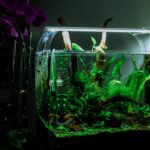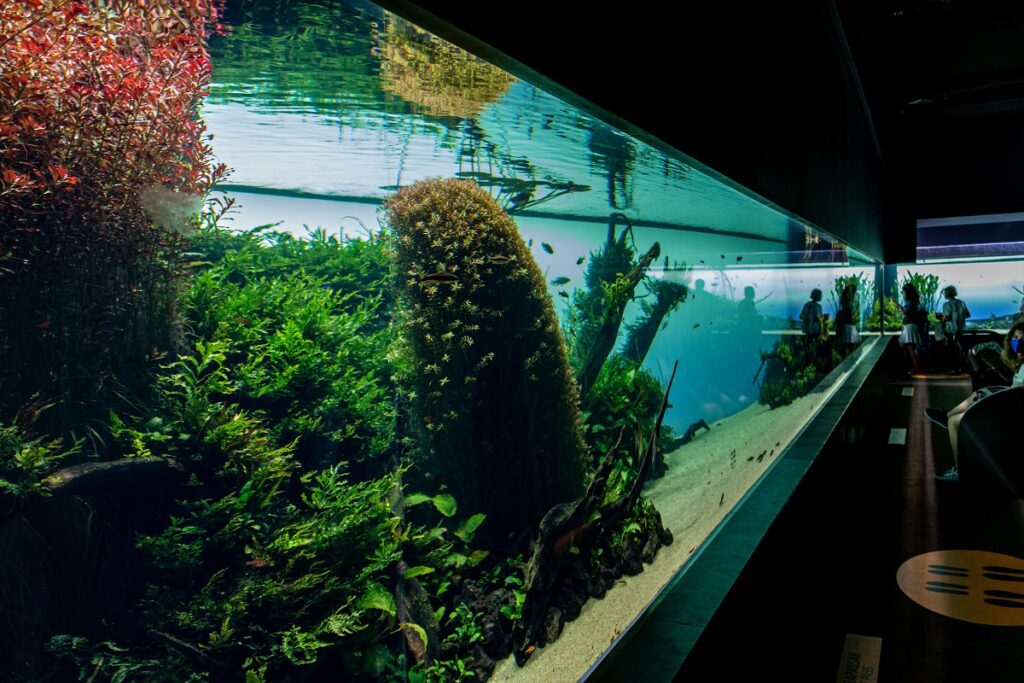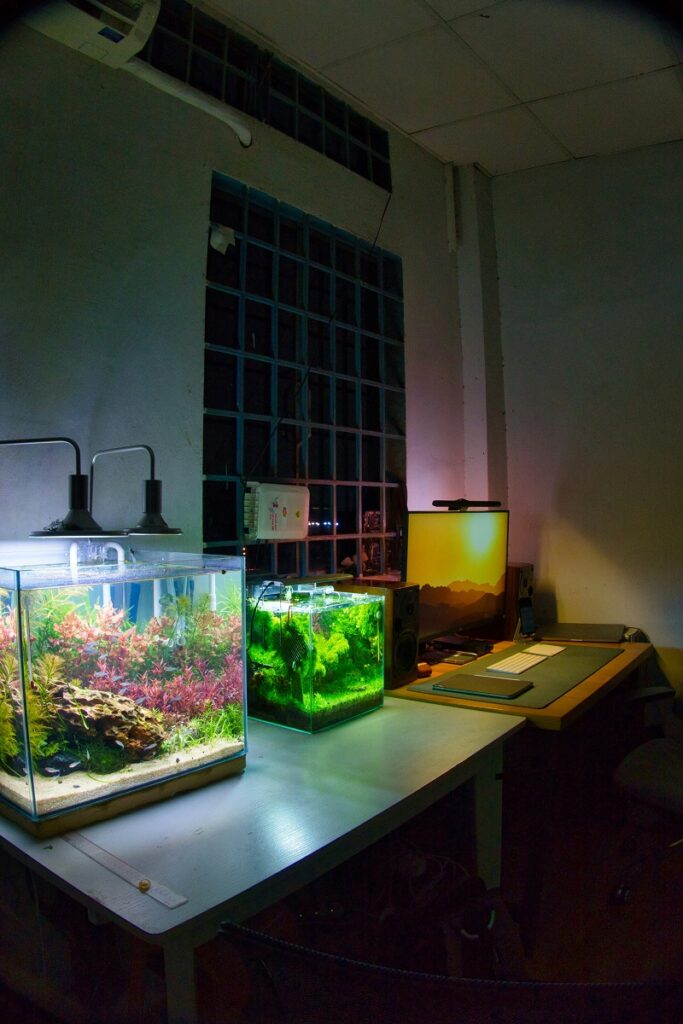Lighting for Your Planted Tank | Understanding PAR & More
Thinking about setting up a planted aquarium? Or maybe your planted tank has been running for a while, but things aren't really going the way you want them to? One of your most important considerations is light. The right amount and type of light can make or break an aquascape!
So what should you be looking for? How do you measure whether your aquarium lights are strong enough? You may have heard of the term "PAR", but what does it actually mean?! Don't panic: The Shrimp Farm explains all about lighting for your planted tank, how to measure it, and what to make of the readings.
Table of Contents
Types of light sources
Let's start at the beginning: selecting the right light source. Plants will not grow if you just use ambient light or a small bulb! A lot of aquariums, including our own rimless tanks, come without a light so that you've got the liberty to select a proper system yourself. There's a lot to choose from, though, and it can be easy to lose the forest for the trees.
First off, think about dimensions. Light sources have different sizes and their beams may vary in width; you'll want a light that illuminates every corner of your tank. Depth is also important, because the further light has to travel through water, the more it weakens. You'll need a stronger light source for a deeper tank.
Back in the day, aquarists would use incandescent lights, but those aren't sold for aquariums anymore as they're real power slurpers and produce a lot of heat. The types you can choose from nowadays are:
- Metal halide lights: Extremely bright (maybe too much so for freshwater tanks) and broad-spectrum light, but emit significant heat. Popular for deeper aquariums and reef tanks.
- Fluorescent lights: Just your regular lighting tube. Energy efficient, decent light output, and cheap, although they have to be replaced regularly. You can usually choose between classic T8 (wider, slightly less efficient, cheaper) and modern T5 (thinner, more efficient, more expensive).
- LED lights: These have taken the market by storm and are now the preferred choice for many aquarists. They can be pricey, but last for ages and are highly energy efficient.
In most cases, we'd recommend investing in an LED unit. They're becoming more and more affordable and their quality is still improving fast. They usually need minimal maintenance and most come with a range of options, like a dimmer or the possibility to emphasize different light spectrums (red, blue, green).
Tip: Bought a light source that doesn't quite reach all the corners of your tank, or want to focus the beam in a specific spot? Ask your local aquarium store about reflectors or lenses. If the light is too bright, it may help to place it a bit higher above the tank.
How strong should my lights be?
Understanding PAR
If you're new to all this, trying to figure out aquarium lights can make you feel like your head is going to explode. Lumen, Watt, PAR, different LED colors, light temperature... what does it all mean, and most importantly, which parameters should you pay attention to?
Traditionally, aquarium light strength would usually be expressed in Watts. This is a unit of power, though, not output. It became more or less obsolete when LEDs began to be used, because LED lights produce much more powerful lighting at the same wattage than fluorescent lights—not to mention incandescents.
Other units commonly used to measure light are lumen (the amount of light a lamp puts out) and lux (the amount of light that reaches a surface). These give a good idea, but they don't directly measure the amount of energy available for plant photosynthesis, instead focusing mostly on the light wavelengths that humans can see. Plants use more than just those visible parts of light.
So what does that leave us with? PAR is the way to go! It refers to the spectrum of light that plants actually use for photosynthesis, ie., the light available for plant growth. It's easy to see how that's more relevant than the other metrics discussed above.
You don't have to remember this, but: the PAR spectrum measures light between 400 (more red) to 700 nanometers (more blue/violet), which is the wavelength that plants use. It's measured in µmol, also called micromole, which measures the quantity of photons (light particles). This corresponds to the amount of light useable by plants.
PAR required for aquarium plants
So: just like terrestrial plants, aquarium plants need light to photosynthesize, which allows them to grow. The amount of light available for them to do so in your aquarium is measured in PAR. But what kind of PAR output are you looking for?
Although opinions do differ on this topic, here's a rough overview:
| Light level | PAR reading | Suitable plants |
| Low | 10-30 µmol | Anubias, Java fern, Java moss, Cryptocoryne, Bucephalandra |
| Medium | 30-50 µmol | Amazon sword, water Wisteria, dwarf Saggitaria, hairgrass, tiger lily |
| High | 50+ µmol | Baby tears, pearl weed, Glossostigma, Rotala wallichii |
Most of the plants in the low PAR section will do fine in higher-light conditions, but it's important to keep an eye on the Co2 levels in your aquarium too. In high-light set-ups, it's pretty much a must to dose Co2. If you don't, the strong lighting will absolutely cause algae to take over slow-growing plants such as Bucephalandra—and potentially your entire tank.
Alternatively, the plants in the medium and high-light sections can make do with a little less in most cases, but they will by no means look their best. Carpet plants like Glossostigma will stretch in search of light, becoming tall and lanky. Colored species, like Rotala, can revert to green if they don't get enough light.
Measuring PAR
You're probably wondering by now how one actually finds out the PAR level for their light and their specific tank. Well, some reputable, established brands list accurate but rough PAR values at different depths on their product pages. It isn't a given that you'll be able to find the output for your particular light, though, and the exact readings are dependent on your individual tank.
If you're looking to take your aquascape to the next level, or if you're having trouble with your plants and suspect they're not getting the right amount of light, you could invest in a PAR meter. They're not the cheapest, though, and you can expect to spend at least $150.
Those on a budget can try asking their local aquarium store if they offer PAR meter rentals (some do!). Alternatively, you could look into light meter apps for your phone, such as Photone. Although the latter might not be the most accurate option, aquarists testing Photone against their PAR meters have found that the app at least gives you a pretty good idea.
Tip: It's recommended to measure the PAR level at the bottom of your tank, not the top. As light penetrates water, it's partially absorbed and scattered. Your plants are usually at the bottom, not the top, so measuring there gives you a much more realistic idea of how much light they're actually getting.
To keep in mind
- You should keep the aquarium lights on for around 8 hours a day. More than that, and you're inviting algae; less, and your plants may struggle.
- We recommend using a timer so you don't have to turn the lights on and off manually.
- Lights don't last forever. LED technology has a much longer lifespan than something like the classic T5 or T8 fluorescent light (which should ideally be replaced every 1-2 years), but still. A PAR meter can reveal whether your light is still working as it should.
- Aquarium plants look best when the color temperature (measured in degrees Kelvin) is around 5500-6500K, which roughly corresponds with natural daylight. If you prefer, though, you can go higher (which results in a blue hue) or lower (which gives a warm glow).
- Full-spectrum LED lights that cover all the wavelengths a plant needs are now available. They give the best results, but they are still quite pricey. Luckily, for most tanks, it's fine to opt for LEDs that contain a mix of white, red, and blue (plus possibly green for aesthetic purposes) diodes.
Frequently asked questions
There's a good chance they're not getting enough light. This can cause them to stretch in an attempt to reach the light source, and red plants may lose their nice colors.
Algae in the aquarium are a complex issue. Excess nutrients can play a role, but so can excess light if you're not dosing Co2. If your lights are very strong, you'll want to think about dimming them or setting up a Co2 supplementation system to keep things balanced.



 Shrimp
Shrimp Fish
Fish Crab &
Crab & Plants
Plants Foods
Foods Snails
Snails


